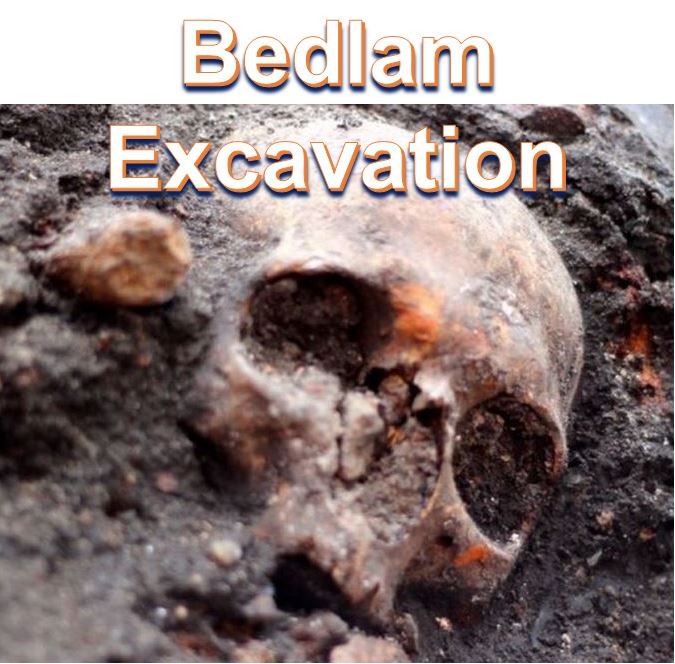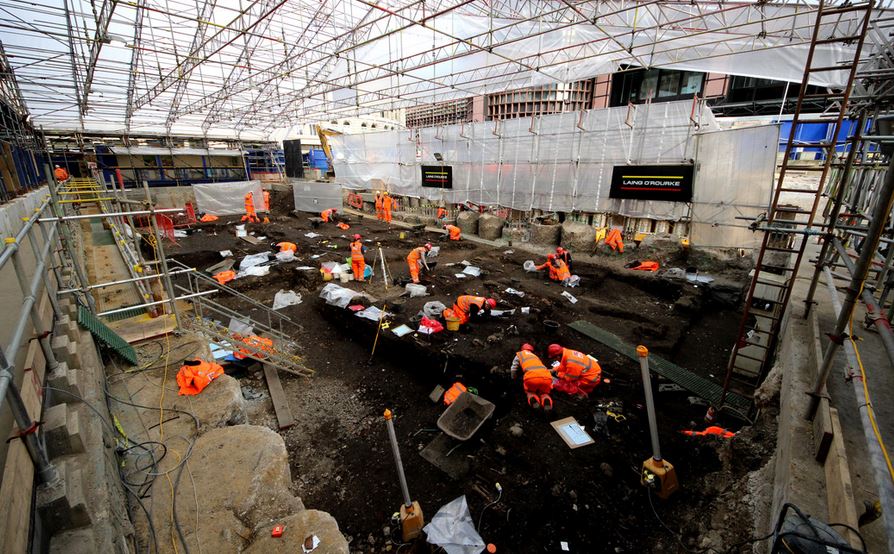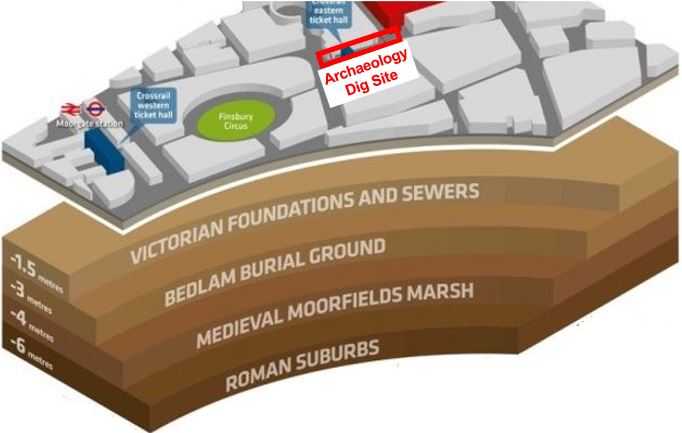London’s first municipal burial ground, Bedlam, dating from 1569 to 1738, is being excavated by archeologists before Liverpool Street Station’s ticket office is built on top. Osteologists (scientists specialized in bones) say the data they gather from the 3,000 skeletons estimated to be excavated will help them better understand the evolution of the plague bacteria strain.
The last Great Plague in London occurred in 1665, exactly 350 years ago. It was estimated to have killed about 100,000 people, or nearly one-quarter of London’s population.
Sixty archaeologists will be working shifts, six days a week for the next four weeks.

Scientists say they expect to learn more about the plague bacteria strains after examining the skeletons. (Image: Crossrail)
The excavation is being carried out by the Museum of London Archeology (MOLA) on behalf of Crossrail Ltd., the company that is building the 73 mile (118 km) railway line, called Crossrail, in central and greater London.
According to Crossrail, Bedlam is London’s most valuable 16th and 17th century cemetery site.
Bedlam spans nearly two centuries, from the birth of the British Empire, the civil wars, Shakespeare’s plays, the Restoration, the Great Fire of London, and a large number of plagues that blighted the capital.
Jay Carver, Crossrail’s lead archaeologist, said:
“This excavation presents a unique opportunity to understand the lives and deaths of 16th and 17th century Londoners. The Bedlam burial ground spans a fascinating phase of London’s history, including the transition from the Tudor-period City into cosmopolitan early-modern London.”
“This is probably the first time a sample of this size from this time period has been available for archaeologists to study in London. The Bedlam burial ground was used by a hugely diverse population from right across the social spectrum and from different areas of the City.”

Sixty archaeologists are working shifts, six days per week, during the whole of March. (Image: Crossrail)
The Museum of London Archeology’s Project Manager, Nick Elsden, said:
“Construction for Crossrail is providing rare and exciting opportunities for archaeologists to excavate and study areas of London that would ordinarily be inaccessible, such as under established road-systems.”
“There are up to six metres of archaeology on site, in what is one of the oldest areas of the city, so we stand to learn a great deal.”
The archaeologists say they also plan to learn more details from the excavation, including how Londoners at the time lived, their lifestyles, diet, migration patterns, and demography.
After Osteologists have carried out tests on the excavated skeletons at the Museum, they will be reburied in a consecrated burial ground.
Roman road below the skeletons
After four weeks of collecting skeletons, the archaeologists will look for roman remains and medieval marsh deposits which lie deeper down.
The ruins of a Roman road lie below the Bedlam burial ground. Archaeologists hope to find some interesting artefacts. They have already found some horseshoes and cremation urns.

The archaeologists will be digging down four layers below Liverpool Street, each one representing different periods in history. (Image: Crossrail)
By the end of September 2015, all the excavation work will be finished and contractor Laing O’Rourke will take over and build the new Eastern ticket hall.
Crossrail wrote:
“A programme of public events are planned over the coming months that will allow the public to sign up for to find out all about the exciting finds that will be uncovering as we excavate through the layers of London history at Liverpool Street.”
About the Bedlam burial ground
The Bedlam Burial Ground, also known as Bethlehem (or Bethlem) and the New Churchyard, was located just outside London’s City Wall.
It was the capital’s first municipal burial ground and was used by people who could not afford a “proper church burial”, as well as individuals who for religious or political reasons chose it as their resting place.
In times of high death rates, such as epidemics or occurrences of plague, it served as an ‘overflow’ for other cemeteries that could not cope.
During the Civil Wars, Levellers formed part of a political movement that believed in equality before the law, religious tolerance, popular sovereignty and extended suffrage. Famous Levellers, such as John Lilburn and Robert Lockyer were buried at Bedlam.
Crossrail, which is overseeing the UK’s largest archaeological project, now has over 10,000 artefacts and fossils dug up from under the ground at more than 40 construction sites in London, some of them dating back 55 million years.
Crossrail video – Liverpool Street excavation
Jay Carver talks about the archaeological dig that is underway at Liverpool street.
